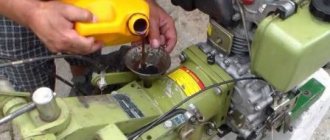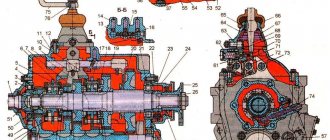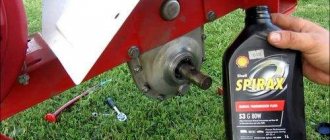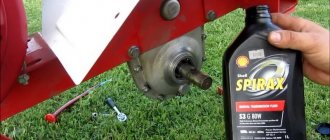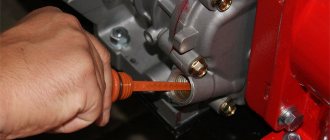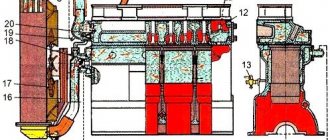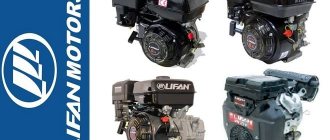YaMZ-236 is a six-cylinder diesel engine designed for large trucks and buses. The engine that replaced the YaAZ-204 and YaMZ-206 is more economical and has a new four-stroke layout (instead of the two-stroke of its predecessors). The engine became part of the large-scale dieselization of Soviet commercial vehicles in the 1960s. At that time, the YaMZ-236 was considered very modern due to its high specific performance.
There were several modifications of this engine, including eight-cylinder versions, as well as turbocharged ones. The most powerful versions were installed on heavy-duty MAZ and Ural vehicles, K-700 tractors, armored personnel carriers, construction equipment, etc. Moreover, the heaviest vehicles were equipped with 12-cylinder YaMZ-240, built on the basis of the same YaMZ-236.
How much oil to fill in the YaMZ 236 engine
The design of the YaMZ-236 includes a mechanical injection pump and direct fuel injection. The injection pump and intake camshafts are located in the camber of the cylinder block, which have two valves (for each cylinder). The piston stroke is 140 mm, and an OHV manifold valve mechanism is also provided. The V-shaped diesel engine with a 90-degree cylinder arrangement is liquid-cooled and can have different power levels. In the basic 150-horsepower version it is designated YaMZ-236G. The 165-horsepower version. With. – YaMZ-236NB, and for 175 liters. With. – YaMZ-236DK. The most powerful modifications YaMZ-236BE2 and YaMZ-7601 produce 250 and 300 horsepower, respectively.
Diesel engines since 1962
YaMZ-236, 11.0 l (150-250 hp), oil volume - 24 (atmospheric) and 28 (turbocharged) l, approval - API-CC; viscosity index – GOST 25371; kinematic viscosity - GOST 33. In summer, fill in M-10-G2K oil; and in summer you should use M-8-G2K.
YaMZ 236 device
The V-shaped internal combustion engine is a standard 6-cylinder design with a 90-degree camshaft. In the original version, the direct fuel injection system is combined with an atmospheric air line. To increase performance, the manufacturer installs a turbocharger on the unit.
The engine crankshaft pushes the connecting rods in pairs, which allows the power unit to operate smoothly and maintain the required efficiency.
The dimensions of the 11 liter unit are impressive, which imposes certain restrictions on transport applications. Motors are usually installed on heavy trucks, tractors and buses.
YaMZ 236 diagram
Operating principle of YaMZ 236
The functioning of the YaMZ engine is standard for most lower engine designs. The distributor drive is gear-type with pusher rods. This design is bulky and heavy. The advantage is increased reliability.
The gearbox drive is connected to the engine via a standard flywheel.
Ignition order for YaMZ 236
Shown in the photo above.
Reviews
Kirill, Tula. I have a decommissioned army Ural with a YaMZ-236 diesel engine, which digests any diesel fuel. But it no longer meets modern environmental standards, so this hard worker works at my dacha, where I have a large farm plus a part-time job (helping neighbors, so to speak). The Soviet diesel engine transports any load, and for this it is not at all necessary to increase the speed to maximum.
Nikolay, Ekaterinoslavl. I drive a MAZ truck with this engine. I can’t say that there are no problems with him at all. Yes, it is very high-torque and easy to repair, since it is devoid of capricious electronics. But it’s the unpredictable frequency of repairs that spoils the whole picture. Inspection of the engine compartment is necessary before each departure, and besides, I have intercity cargo transportation.
Malfunctions of the YaMZ 236 motor
The reliable unit is loved by many drivers for its unpretentiousness and ease of operation. The main problems begin with the motor if the equipment is operated without proper maintenance and care.
With proper operation and compliance with the manufacturer's regulations, the internal combustion engine can withstand severe overloads and long runs without detecting problems. Turbo . The technical characteristics of a motor with a supercharger installed are almost identical to atmospheric modifications. The main difference is the installation of a turbine and the replacement of the piston group with a more durable one.
Such units are distinguished by increased power and torque, which allows them to work more efficiently on loaded vehicles and tractors.
History and characteristics of YaMZ 238
The Yaroslavl Motor Plant produces a whole line of engines, the prototype of which can be considered the YaMZ 238. Production of this engine began in 1962. It became an improved version of the previously assembled YaMZ 236 (six-cylinder), but for many years both power units continued to be actively used in parallel with each other. The family has many common features: design features, operating principles, similar technical indicators. Later, the YaMZ 530 appeared - four- and six-cylinder in-line engines, both diesel and gas.
The engines of the Yaroslavl plant serve on powerful MAZ, Urals, KrAZ trucks, tractors and combines, river and sea boats, as well as diesel power plants. Due to its reliability and unpretentiousness, the engine still remains in demand, and its production continues. The newest version of YaMZ-238/Euro-0 Turbo is distinguished by the presence of a turbine. In addition to other design improvements, it is equipped with a liquid-oil heat exchanger and a high-pressure fuel pump.
Maintenance and repair of YaMZ 238
It is recommended to carry out service maintenance of the YaMZ 238 engine after 20,000 - 25,000 km. When checking, the oil pressure should give readings of 4-7 kgf/cm2 on a warm engine. The indicator is the same for atmospheric and turbo systems. Changing lubricants is necessary during scheduled maintenance, as well as when drips, smoke, or knocking appear when the engine is running, while the capacity of different systems varies, as does the replacement time.
You can familiarize yourself with the technology for servicing power units in the repair and operation manual developed by the manufacturer. The set of mandatory operations when carrying out maintenance of an internal combustion engine at the Yaroslavl plant includes the following manipulations:
- Change of oil;
- checking and replacing filters: fine filter,
- coarse filter,
- fuel purification filters,
- eco-filter exhaust system,
- air filter;
Characteristics of YaMZ 238 filling containers
The YaMZ 238 engine uses a mixed-type lubrication system with a “wet” sump.
You can find out how much oil will need to be poured into the YaMZ 238 engine based on the size of the unit’s filling tanks. In particular, the lubrication system has a volume of 32 liters of oil.
The engine cooling system without a radiator requires 20 liters of lubricants. The fuel pump needs 0.2 liters, the air filter capacity is 1.4 liters. The 238 model, unlike the 236, does not have a regulator.
The oil volume in the YaMZ 238 engine is measured using a special dipstick with o and “minimum”. 24-28 liters are poured at a time, despite the fact that the working volume of the lubrication system of this power unit reaches 32 liters. if during operation the oil pressure in the system is increased to more than 520 kPa (5.2 kgf/sq.cm), excess lubricants are returned through the oil line and simultaneously cleaned by filters.
Regulations for changing oil in internal combustion engines
Experienced motorists and specialists recommend changing the oil in the YaMZ-238 engine every 10-15 thousand km. Failure to promptly change engine oil can result in various technical problems. Let's look at them in more detail:
- Used oil does not have enough beneficial and protective properties to effectively dissipate heat, protect the engine from corrosion, and properly lubricate parts. In the absence of high-quality lubrication, dry friction occurs between the components of the internal combustion engine, they overheat, fail and melt
- Fuel consumption increases, various sounds and vibrations appear.
- Wear products and dirt deposits spread through the engine channels.
YaMZ-236 is a widely used diesel engine that is used to equip trucks and special equipment. The motor has existed since the 1960s in various modifications and remains relevant thanks to numerous upgrades. With a working volume of 15 liters, its power ranges from 180 to 420 hp. With. According to data for 2014, the YaMZ-238 has given way to more modern YaMZ-656/658 engines, but is still produced in disassembled form, and its components are supplied for earlier produced cars: MAZ-500/503/504/509/516 ( 180 hp), MAZ-5335 (180-300 hp), Ural 4320 (230 hp), LiAZ-5256 (230 hp), MAZ-104 (230 hp) ) etc.
Engine catalog
YaMZ-236B is a modern diesel engine. for heavy-duty trucks and special equipment, produced at the Yaroslavl Motor Plant (YaMZ). Complies with EURO-0 environmental standards.
Main characteristics
YaMZ-236B is a four-stroke engine with compression ignition. Type of fuel – diesel fuel. V-shaped arrangement of cylinders, cylinder camber angle - 90º, number of cylinders - 6.
The engine can be equipped with a liquid-oil heat exchanger, a mechanism for damping torsional vibrations and a power take-off.
Specifications
| content .. 1 2 3 4 5 6 7 8 9 10 .. TECHNICAL CHARACTERISTICS of engines YaMZ-236M2, YaMZ-238M2 - part 5 Transmission Refill tanks Indicators | Engine models | |||||
| YaMZ-236M2 | YaMZ-238M2 | YaMZ-238AM2 | YaMZ-238VM | YaMZ-238GM2 | YaMZ-238KM2 | |
| Refill tanks, l | ||||||
| Lubrication system (without radiator) | 21 | 29 | 29 | 28 | 29 | 29 |
| Cooling system (without radiator) | 17 | 20 | 20 | 20 | 20 | 20 |
| Air filter | 1,4 | 0,85 | — | — | 0,85 | 0,85 |
| Injection advance clutch | 0,16 | 0,16 | 0,16 | 0,16 | 0,16 | 0,16 |
| Transmission | 5,5 | 5,5 | 5,5 | — | — | — |
Rice. 1. Cylinder numbering scheme: A - YaMZ-236M2 engine; B — engine YaMZ-238M2; C — right row of cylinders; D - left bank of cylinders
content .. 1 2 3 4 5 6 7 8 9 10 ..
Parameter name Value Number of cylinders 6 Cylinder arrangement V-shaped, camber angle 90° Cylinder operating order 1-4-2-5-3-6 Cylinder diameter, mm 130 Piston stroke, mm 140 Displacement, l 11.15 Compression ratio 15 ,2 Rated power, kW (hp), no less than 184 (250) Nominal crankshaft rotation speed, rpm 2000 Idle speed, rpm - maximum, no more than 2175 - minimum, no more than 550- 650 Specific fuel consumption at 2000 rpm, g/(kW h): — at 100% power: 216 Oil consumption for waste, % of fuel consumption, no more than 0.5 Two oil filters: full-flow with a replaceable filter cartridge and centrifugal Fuel pump type E607.1111005, high pressure six-piston, spool type Fuel filters: - coarse cleaning with replaceable filter elements - fine cleaning with replaceable filter Gas turbine supercharging Turbocharger with a radial centripetal turbine and a centrifugal compressor Cooling system liquid, closed type, with forced circulation coolant, designed for all-season use of low-freezing liquids Centrifugal water pump with V-belt drive from the crankshaft Axial type fan, with flow direction from the engine to the radiator, constant drive Alternating current generator, model 1322.3771 Starting device electric starter, model 2501.3708-21 according to TU 37.003 .1059-81 LU Filling volumes, l: - lubrication system 24 - cooling system 17* Overall dimensions (LxWxH), mm 1276x1045x1105 Engine weight, kg 950** Service life before major overhaul, h 20000* without radiator filling volume
** dry engine weight
Application
The YaMZ-236B engine is designed for installation on tracked tractors, all-terrain vehicles, excavators and other road construction equipment.
